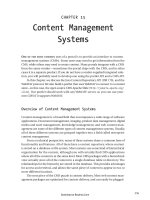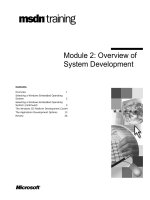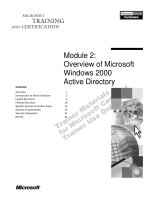Information Management Resource Kit Module on Management of Electronic DocumentsUNIT 5. DATABASE MANAGEMENT SYSTEMS LESSON 6. TEXTUAL DATABASES AND CDS/ISIS BASICSNOTE Please note that this PDF version does not have the interactive features offered th doc
Bạn đang xem bản rút gọn của tài liệu. Xem và tải ngay bản đầy đủ của tài liệu tại đây (696.55 KB, 17 trang )
5. Database management systems - 6. Textual databases and cds/isis basics – page 1
Information Management Resource Kit
Module on Management of
Electronic Documents
UNIT 5. DATABASE MANAGEMENT SYSTEMS
LESSON 6. TEXTUAL DATABASES
AND CDS/ISIS BASICS
© FAO, 2003
NOTE
Please note that this PDF version does not have the interactive features offered
through the IMARK courseware such as exercises with feedback, pop-ups,
animations etc.
We recommend that you take the lesson using the interactive courseware
environment, and use the PDF version for printing the lesson and to use as a
reference after you have completed the course.
5. Database management systems - 6. Textual databases and cds/isis basics – page 2
Objectives
At the end of this lesson, you will:
• understand the functionalities offered by
CDS/ISIS, a textual DBMS;
• understand the technical work needed by
developers to implement these functionalities;
• understand when you should use CDS/ISIS.
Introduction
Imagine you need a system to store,
retrieve and disseminate data describing
textual resources such as books,
projects, papers, etc.
In this case, textual databases
containing bibliographies,
webliographies, project descriptions,
etc., can match your needs.
CDS/ISIS (Computerised Documentation
Systems/Integrated Set of Information
Systems), is a textual database
management system designed to build
and manage textual databases.
5. Database management systems - 6. Textual databases and cds/isis basics – page 3
What does CDS/ISIS offer?
CDS/ISIS was designed in order to provide some important functionalities for document
management.
There are many different versions of CDS/ISIS, which share following common features:
Handling different languages and scripts
Let’s review together the importance that these functionalities have for the user…
Handling the structure of textual databases
Text-oriented formatting
Fast and powerful retrieval
¦pªG¦³¿
®Ñ©
Textual databases come with…
1) Elements with a highly variable length (like titles or
abstracts).
2) Elements that come with an unknown number of
occurrences (like authors).
3) Groups of elements that should be processed as a group
(like author’s initials and author’s surnames);
for example, you may want to render author’s names in
different ways, like “Renard, Guyon”, or “Claude Renard &
Jean Guyon”, or “Renard C.; Guyon J.”, etc.
CDS/ISIS satisfies these needs, as…
1) It does not reserve a fixed length for fields or records,
although there is a maximum.
2) It allows a field to be defined as repeatable.
3) If the names have been stored appropriately, it can
render them in different ways.
What does CDS/ISIS offer?
“Thomson, Metz”
“Alex Thompson & Marc Metz”
“Thompson A ; Metz M.”
Implications of economic policy for
food security - A training manual, by
A. Thomson, and M. Metz.
Implications of economic policy for
food security - A training manual, by
A. Thomson, and M. Metz.
Macroeconomía y políticas agrícolas:
una guía metodológica
Implications of economic policy for
food security - A training manual
5. Database management systems - 6. Textual databases and cds/isis basics – page 4
How can users search data with CDS/ISIS?
Normally you search all data that has been
indexed, but with CDS/ISIS searches can be
restricted to certain fields: for example, users can
search the titles, the author’s names, the
keywords, etc.
Users also can truncate to search for words with a
stem.
This technique allows a search on leading
sequences of characters. CDS/ISIS will
automatically include all search terms having the
specified root. Right-truncation is indicated by
placing a dollar sign ($) immediately after the
last root character.
$
What does CDS/ISIS offer?
Also, users can combine terms using ISIS “logical” or “ boolean” operators.
The three most important ones are:
Operator
ISIS Syntax
Action
Example
AND
OR
NOT
Intersection
*
a query goats * sheep retrieves records
where both goats and sheep occurs
Addition
+
a query goats + sheep retrieves
records where either goats or sheep occur,
or both
Exclusion
^
a query goats ^ sheep retrieves all records
where goats occurs, unless sheep occurs
in the same record
Note: Be careful with the “NOT” operator. You would exclude works that are both
on goats and sheep, thus miss useful information on goats.
What does CDS/ISIS offer?
5. Database management systems - 6. Textual databases and cds/isis basics – page 5
fish * diseases
fish + diseases
fish ^ diseases
“I’m looking for documents on fish diseases”.
What is the best expression for this search?
Click on your answer
Boolean operators
For example, for some fields the developer may have
decided that each word is a separate entry. To search
for adjacent words like compound keywords user can
then use adjacency operators.
The ways of searching also depend on the database design, so these are defined by the
database developers.
PLANT . BREEDING searches for the
two words next to each other
PLANT BREEDING there may be
one word in between
However, the database designer may have chosen
that only those phrases in a certain field will be
indexed that are between slashes or between <>
(square brackets).
If such a field contains <Plant
breeding> the record can be found
by searching PLANT BREEDING.
More sophisticated things are possible.
The database can be designed in
such a way that searches can be
restricted to certain fields by using
prefixes, like AU=PLATO or
TI=Dialogues
What does CDS/ISIS offer?
5. Database management systems - 6. Textual databases and cds/isis basics – page 6
A database management system should not just display the characters
correctly, but also be aware of the sequence of these characters in a
script, especially when it sorts data and builds indexes.
It should also understand which upper case character corresponds with
which lowercase character.
ISIS has solved this by using two tables:
• ISISUC.TAB, that defines the correspondence of upper case and lower
case, and
• ISISAC.TAB, that defines the alphabetic characters and their sequence.
Even advanced developers of ISIS applications will seldom use these
features, but it is useful to know that CDS/ISIS can be adapted.
What does CDS/ISIS offer?
¦pªG¦³¿
®Ñ©
a A
Finally, another important functionality is the ability to handle different languages
and scripts. In fact, you need to be aware about character encoding, especially with
non-Latin scripts.
What does CDS/ISIS offer?
We think CDS/ISIS is a good solution
for us, but some features should be
adapted to better match our needs…
It is possible to do this?
Developers can adapt CDS/ISIS
depending on the required features.
They can personalize the system in order
to match your organization’s needs.
But not all the adaptations can be made,
and not all involve the same amount of
work.
To better understand these capabilities
and the work required, let’s design a
CDS/ISIS database.
5. Database management systems - 6. Textual databases and cds/isis basics – page 7
Developers have to create a series of files in order to design and build a CDS/ISIS Database.
Designing a CDS/ISIS database
Developers must define: To do so they create
following files:
With following extension:
Which kind of fields there are. Field definition table
Display formats
Field select table
Worksheets or web forms
.fdt
How to display the data. .pft (written in the formatting
language)
How to search the data. .fst (also used to print sorted
output)
How to input data. .fmt (needed in a stand-alone
Application, not in a web
environment)
Let’s have a look at them…
Defining fields
MFN
Author(s)
Name (^n)
Affiliation (^a)
E-mail (^m)
Title …
Record 1 1
^nSalih, A.G.
^a Institute National de
Recherche Agronomique
^
…
Record 2 2 …
…… …
CDS/ISIS databases are organised collections of records each of them describing a resource (book,
paper, project etc ).
Records contain different data elements: fields and subfields, which represent attributes of the
described resource, such as title, author, abstract etc
FIELD
(Author)
SUBFIELDS
FIELD (record
number)
FIELD
(Title)
Occurrence 1
^nDrilleau, G.F.^aStation de
Recherches Cidricoles
^
Occurrence 2
RECORD
5. Database management systems - 6. Textual databases and cds/isis basics – page 8
CDS/ISIS can have a maximum of two levels of data hierarchy (father-child) within a record
(fields and subfields).
The fields and subfields may have variable length, and each of them may have any number of
occurrences.
In this example, you have a repeatable field (Author) with subfields (name, affiliation, e-mail)
for each occurrence. Subfields are delimited with subfield delimiter (^).
Occurrence 1
Occurrence 2
Defining fields
Fields can be defined in different
ways depending on the kind of
resources and on how you want to
use the database.
Developers create the Field
Definition Table which
describes:
•the record structure (e.g.
Title, Date, Authors, etc.), and
•the characteristics (maximum
length, subfields, etc.) of fields
and subfields.
Field number
(tag)
Field name
Max Length
Type: alphabetic,
numeric, etc. (X, A, N,
P)
Repeatability
Subfield
delimiters
Defining fields
5. Database management systems - 6. Textual databases and cds/isis basics – page 9
MFN: 2
44: Methodology of plant eco-physiology
50: Incl. bibl.
69: Paper on: plant evapotranspiration
26: ^c1965
70: ^nBosian, G. ^
70: ^nSmith, J.
For example, this bibliographic record follows a
specific predefined structure.
Can you classify the following elements?
Record number
Subfield delimiter
70
^n
Click on your answers
Field number
Bosian
Data
(occurrence 1)
Data
(occurrence 2)
Smith
Defining fields
Displaying data
10: Of war and peace
20: ^aTolstoy^bLeo
The format: Will result in: Because:
v10 Of war and peace
Of w
and
UC(v10) OF WAR AND PEACE UC = Upper Case (converts all letters to upper case)
v20 ^aTolstoy^bLeo v20 displays the field 20
v20^a Tolstoy ^a displays only the subfield “a”
Tolstoy, Leo
v10 displays the field 10
v10.4 . Precedes the number of characters (in this case, it displays the first
4 characters)
v10*8.3 * precedes the offset (in this case, it displays 3 characters starting
from the eighth character)
mhl(v20) mhl = Mode Heading Lowercase (separates subfileds with a comma;
it leaves case untouched)
Also, fixed texts (“literals”) can be inserted: “Title: “v10 will result in Title: Of war and peace.
Developers can define how the data will be displayed by writing some lines in the ISIS
formatting language.
For example, let’s look at some ways the following data can be displayed:
5. Database management systems - 6. Textual databases and cds/isis basics – page 10
Defining searches
Another important thing to decide is…
How will users search with
CDS/ISIS?
In order to provide fast retrieval in a library it
is necessary to catalogue documents in the
most appropriate way.
Therefore, librarians need to reflect on what
type of catalogues they want to create.
Then developers will design and build a
permanent index, called an “inverted file”. To
do this, they need to reflect, like librarians, on
which data need to be indexed.
Let’s look at an example of an inverted file…
Defining searches
Imagine we have a database with records containing title fields (n.24). We can invert these data
by creating an index.
The inverted file contains extracted search terms, together with links to the records from which
they were extracted.
RECORD 1
INDEX (INVERTED FILE)
This word: is in record:
about 2
ado 2
all 1
ends 1
henry 4
is 1
IV 4
much 2
king 3,4
lear 4
nothing 2
that 1
well 1
…
24: All is well that ends well
…
RECORD 2
…
24: Much ado about nothing
…
RECORD 3
…
24: King Lear
…
RECORD 4
…
24: King Henry IV
…
5. Database management systems - 6. Textual databases and cds/isis basics – page 11
Format for data extraction
Indexing technique
Key (field) number*
Field Select Table
Developers control what goes into the inverted file by defining a Field Select Table.
*It is good practice to let key 24 correspond to field 24.
By choosing the Indexing technique developers can decide to extract the whole field, each occurrence
of a field, everything between text markers like/ / or <>, each word in a field.
By using the formatting language, they can format terms in the inverted file.
In this example, the Field Select Table
contains a line saying:
• which key number assign to the extracted
term (24);
• which indexing technique must be used
(4); and
• the formatting language used to extract a
string from a field (V24 extract content of
the field 24).
24 4 (V24)
Defining searches
For example:
In a database there are records from Senegal and Burkina Faso. Their record id’s are:
SE20030201004
BF20030605002
SE20030731005
If ISIS indexes the whole field, the index would be:
BF20030605002
SE20030201004
SE20030731005
But by using the formatting language to format only the first two characters, the index
would just be:
BF
SE
Now an index on the code for country of origin has been created.
Defining searches
5. Database management systems - 6. Textual databases and cds/isis basics – page 12
For web versions web pages are used to input
or modify data, for other versions Worksheets
have to be defined for that purpose.
They can be defined in such a way that they
help to ensure data consistency.
Fields can have a default value, be defined as
alphabetic or numeric, or the data must be
according to a certain pattern.
Worksheets cannot enforce that the user picks
values from a predefined list, or fills in certain
mandatory fields.
How can I insert my information into the
database?
Defining data input
When to use CDS/ISIS
Before ending, let’s focus on the strong and
the weaker points of CDS/ISIS.
This could be useful in deciding if this system
matches your needs.
The following are the main strong points of
CDS/ISIS:
• fast retrieval in data with large pieces of
unstructured texts; and
• managing of textual data in non-Latin
scripts or languages with specific uses of
accented characters.
5. Database management systems - 6. Textual databases and cds/isis basics – page 13
• reformatting of numerical data: e.g., there are limitations if you want to convert
integers into real numbers or floating-point numbers.
• managing data that is being changed all the time: if a record is deleted or
modified, special reorganization procedures must be carried out to remove old data.
• data input from standardized lists: such links between tables are not a standard
feature, so if you have the same name stored in different records, and you want to
change it, you have to do it in each individual record.
When to use CDS/ISIS
On the other hand, weaker points of CDS/ISIS are:
However, the program offers some facilities for standardization, like the ability to define default
values in a worksheet.
Special applications and plug-ins have been developed to enable, for example, data input from a
thesaurus.
Summary
• CDS/ISIS as a textual DBMS is used for developing and managing
free-structured textual databases and can be tailored for different
applications.
• The system manages:
- the structure of textual databases,
- text-oriented formatting,
- fast and powerful retrieval, and
- the usage of different languages and scripts.
• Through specific files, developers can define:
- the structure of fields,
- how to display the data,
- how to search the data, and
- how to input data in the database.
• CDS/ISIS is particularly effective for retrieval in data with big pieces of
unstructured texts, and for textual data in non-Latin scripts (or
languages with specific usage of accented characters).
5. Database management systems - 6. Textual databases and cds/isis basics – page 14
Exercises
The following five exercises will allow you to test your understanding of the concepts covered in this
lesson.
Good luck!
Exercise 1
What is CDS/ISIS?
A set of tools for relational database
management
A textual database
A set of tools for textual database
management
Click on your answer
5. Database management systems - 6. Textual databases and cds/isis basics – page 15
Exercise 2
What is the function of the Field Definition Table?
It is a list of the different elements that can be distinguished in a
piece of information, and their properties.
It contains extracted search terms together with links to the
records from which they were extracted.
It selects data from fields or subfields and formats the information
for display.
Click on your answer
Exercise 3
Let’s consider this fragment of a Field
Definition Table.
Subfield delimiters
Field name
Imprint
30
Series
R
Click on your answers
Field number
Can you identify the following elements?
Repeatability
abc
5. Database management systems - 6. Textual databases and cds/isis basics – page 16
Exercise 4
What are the features of…
defines rules for extracting key terms from a
record and storing them in the index.
Click on your answer
Field Select Table
contains extracted search terms together with
links to the records which they were extracted
from.
Inverted File
1
a
Exercise 5
In which of the following situations could CDS/ISIS be the appropriate choice?
to store, retrieve and disseminate administrative data that
change on a regular basis.
to store, retrieve and disseminate books and articles in different
languages.
Click on your answer
5. Database management systems - 6. Textual databases and cds/isis basics – page 17
If you want to know more
CDS/ISIS originates from Unesco
Their ISIS site ( provides information
about their work on ISIS including links to websites from the user
community.
Bireme
is an important developer of versions of ISIS.
Their product catalogue gives access to information on these products
(under tools). See:
/>Some of the products on this CD-ROM have been produced by the
Institute for Computer and Information Engineering (ICIE), Warsaw,
Poland.
On you can learn more about their products
and development work (see "products").









